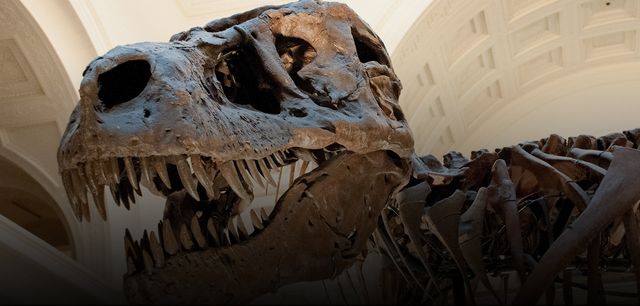16 march 2023
In “Jurassic Park”, researchers find blood from a dinosaur in a mosquito embedded in amber: they use this to recreate the giant reptiles – first with impressive but then with disastrous consequences. But will it ever be possible to bring dinosaurs or other animals from prehistoric times back to life?
Things that work seamlessly in fiction are often not quite as easy in real life. The same applies to dinosaur DNA retrieved from amber. From the outside, this fossilised tree sap looks like the ideal vessel for life forms. After all, mosquitos and other insects found embedded in it appear to be perfectly preserved. However, amber has a high water content, which promotes the degradation of DNA. And this degradation means that all that is usually left post mortem of the animals encased in the amber is their exoskeleton – which basically never contains DNA. For this reason, prehistoric animals which have been refrigerated in permafrost, mummified in bogs or calcified are considered to be much more promising DNA sources. But they do not remain intact for ever either.
A question of half-life
When an organism dies, its DNA gradually degrades. The half-life of an animal’s genetic material is about 521 years. After this period has elapsed, only half of its DNA will remain; after another 521 years this will be reduced by half again, and so on. If it is well refrigerated – to be specific, at a temperature of minus five degrees Celsius – this half-life can be extended to 158,000 years, as an international team of researchers has found out. It is therefore entirely possible for prehistoric genetic material to survive for up to one million years. But the big dinosaurs departed this life some 66 million years ago. So the prospect of finding enough viable DNA material in what remains of them today is therefore vanishingly remote.
Breeding tyrannosaurs from chickens
And yet, the dream of resurrecting dinosaurs lives on. US palaeontologist Jack Horner has pinned his restoration hopes on the descendants of the prehistoric sauria: birds. He wants to use genetic manipulation to reverse the evolutionary process and restore the long-lost saurian characteristics of today’s birds. Other researchers in the US have actually managed to create chicken embryos with reptilian snouts. Unlike Horner, however, they merely want to find out how birds came by their beaks. Horner’s own experiments, going back many years, to grow lizards’ tails on birds have thus far not borne fruit. So, whether chickens might one day be the progenitors of prehistoric predatory lizards is anyone’s guess.
The comeback of the mammoth?
Other scientists have turned their attention to a more recent creature from prehistory: the mammoth. Unlike dinosaurs, these massive denizens of the steppes have left behind some pretty well preserved genetic material. Harvard researcher George Church now intends to breed this shaggy quadruped anew from the DNA of a mummified mammoth calf. Or, to be more precise, a mammoth-elephant hybrid. This creature should then look and behave like the woolly mammoths which roamed the Siberian tundra until up to 4000 years ago. Church and his team intend, for example, to inject sections of genetic material that will produce a woolly coat and a thick layer of heat-preserving fat into the genetic material of an Asian elephant. This should then give rise to an embryo that would either be delivered by an elephant cow as a surrogate mother or grown in an artificial womb.
Church has now found investors and comrades-in-arms for his mammoth project. With the Colossal start-up, he intends to engineer a mammoth-elephant hybrid embryo by as early as 2027. His vision is this: to have these animals repopulate the Siberian tundra – preventing the permafrost from thawing by scratching layers of snow off the ground with their huge feet and long tusks as they look for food, allowing the cold to penetrate deeper into the earth. This is a prehistoric strategy for climate protection: after all, permafrost soils store huge amounts of greenhouse gases which are released into the atmosphere as they thaw.
Whether Church will actually be able technically to realise his ambitious resurrection project at all, let alone in the envisaged period, is doubted by many in the scientific community. But even if he does, if the footprint of the mammoth is really going to make any kind of difference to the global climate, researchers from Potsdam say that gigantic herds will be needed which will have to grow over many decades, not to mention the billions of dollars of investment that will be required. That’s an awful lot of money, which could also go into other climate protection measures. Or it could be used to preserve some of the 50 animal species which vanish from our Earth every single day. After all, from an ecological standpoint, each one of them is a loss – even if hoverflies and field hamsters don’t have such large and impressive teeth as the mammoth or the Tyrannosaurus rex.
Also interesting
 Everett Collection via picture alliance
Everett Collection via picture allianceA brief history of sound recording
Part 1: From the phonograph to the long-playing record.
Read more


